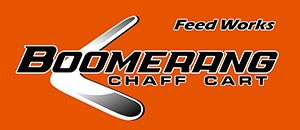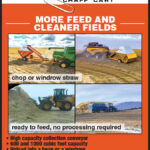Advertisements
Products and Services
A number of factors will affect the efficiency with which livestock will consume the available feed.
The first factor is collection efficiency. If you cannot capture the feed, your livestock cannot eat it. The previous generation of blower fed chaff carts were prone to loss during harvest, caused by turning and wind on the chaff stream. Some of the material is quite fine, especially small seeds which have greater value. The conveyor of the Boomerang successfully addresses this problem. Testing in Australia has shown that over 98% of the material ends up in the chaff heap.
The method of storage and feeding has the next impact. The simplest method of feeding chaff is to graze heaps in the field where they were grown. This is not always an option, requiring fencing, water, etc. Where it is an option, the size of the heaps affects loss and management requirements. A multitude of small heaps requires extensive control fencing, and small heaps are more vulnerable to being buried by snow. The size of the Boomerang gives you the ability to group heaps, either in rows, or in a central location. Many producers would benefit by placing the heaps in parts of the field that would most benefit from additional manure. The cart also has the ability to unload in a longer lower shaped heap as well. This makes it very easy to add supplemental feed on top of the chaff.
If you feed at a central yard, chaff can be transported using a loader with a grapple, and a dump wagon, or by baling with a large square or net wrap equipped round baler. Chaff feeds well from a large bunk using an electric wire to control access. It also mixes well in a feed mixer, as there is very little long material. Mixing with silage, grain, supplements etc. ensures that chaff will be consumed.
Baling chaff, or more accurately ‘straff’ is a recent development. It is one of the capabilities we are focusing on developing with the Boomerang. A small amount of straw is required for baling. Typically the straw chopper on the combine is left in operation, some of the straw will land on the conveyor, typically 10-15% of the total. The remainder of the straw is returned to the field.
The characteristics of chaff have changed along with combine development. Combines, even some conventional ones, are more aggressive in how they handle straw. A large amount of short straw is now traveling over the sieves and becoming a component of the chaff stream. This will affect both the quantity, and the feed value of chaff. More research needs to be done to determine the overall effect. Although the chaff samples that I submitted for testing this year all contained a significant straw component, feed values remained in the typical range.
I do not have data to support it, but I believe that the straw component improves the overall feed palatability and consumption, by making a looser, easier to eat feed. Fine chaff from the previous blower carts tended to pack into a denser mass.
As an aside, the Australian grain farmers who collect chaff for weed control prefer the conveyor cart chaff, as the added straw and looser heap makes burning much easier.



